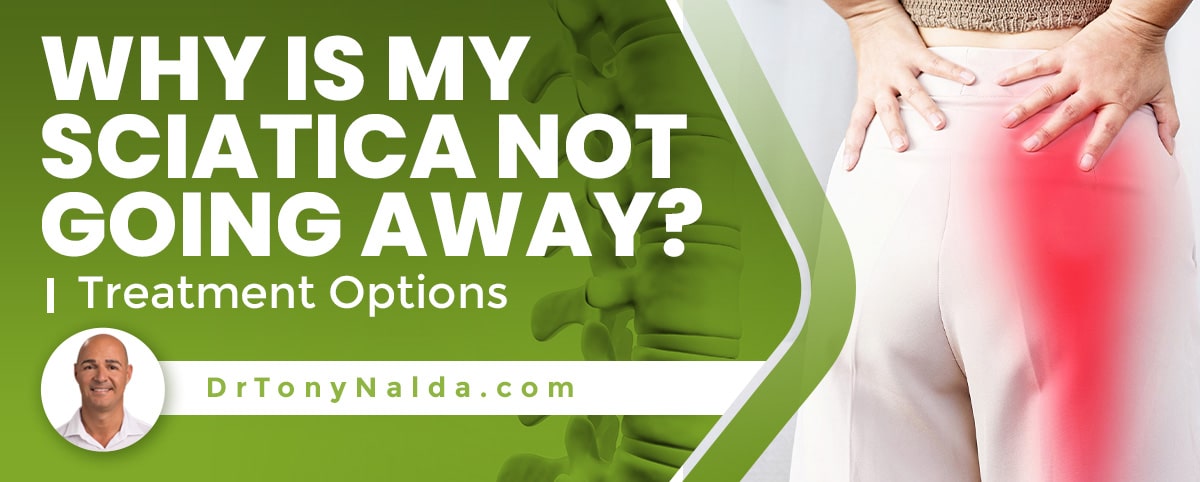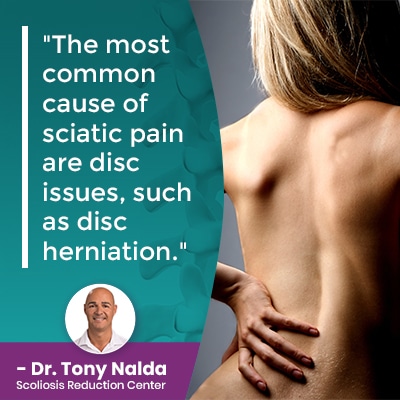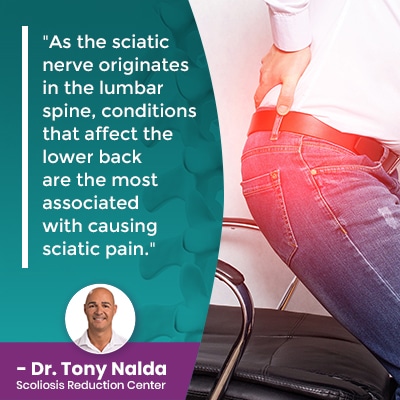Why Is My Sciatica Not Going Away? Treatment Options

While many think of sciatica as a condition in and of itself, it is not; sciatica is, instead, a set of symptoms that are caused by the sciatic nerve being compressed, irritated, pinched, and or impinged. Sciatica refers to pain felt anywhere along the sciatic nerve's pathway.
Sciatica not going away is usually related to the type of treatment, and treatment that doesn't address the underlying cause of sciatic nerve pain will do little for long-term sustainable pain relief.
The sciatic nerve is the largest in the body so let's start with what that means and how sciatica develops.
Table of Contents
What is the Sciatic Nerve?
The sciatic nerve runs from the lower back and extends down the back of the hip, buttock, leg, and into the foot, making it the largest and longest nerve.
The sciatic nerve is a mixed nerve because it contains both sensory and motor fibers, which is why sciatica symptoms can involve both movement and sensation.
There are three main sections of the spine: cervical spine (neck), thoracic spine (middle/upper back), and the lumbar spine (lower back).
As the sciatic nerve starts in the lumbar spine, the direct effects of sciatica are felt in the lower body (pelvis and lower spine, leg and foot).
The sciatic nerve controls lower-leg muscles and the muscles located at the back of the knee, and it facilitates sensation felt by the outer lower leg, the back of the lower leg, the sole of the foot, and the backside of the thigh.
So if the sciatic nerve is exposed to uneven pressure, what happens?
Sciatic Pain
Sciatic nerve pain can feel different from patient to patient, but common symptoms of sciatica include pain felt anywhere along the sciatic nerve's extensive pathway:
- Hip pain
- Leg pain
- Foot pain
- Tingling sensations
- Electric shock-like sensations
- Sharp shooting pains
- Numbness
- Lower-body mobility issues
- Issues with bowel or bladder control (associated with severe cases)
Sciatic nerve pain can range from mild and intermittent to chronic and debilitating, but in most cases, there are periods known as flare ups, when condition symptoms intensify, and then periods where symptoms are milder or go away entirely.
Sciatic pain interferes with the function of the lower body because the nerve controls movement and sensation of the lower body, and when it comes to recurrent sciatica, the best way to decrease pain and help symptoms resolve is to determine the underlying cause of the sciatic nerve pain.
The spine is part of the central nervous system (CNS) and contains 31 pairs of spinal nerves; spinal conditions can affect the health and function of any of the spinal nerves, but in most cases, the area of the body located closest to the affected spinal section is the most likely to feel the condition's direct effects.
So what types of causes are associated with sciatic pain?
Causes of Sciatic Pain
The spine consists of vertebrae (bones of the spine) stacked on top of one another in a straight and neutral alignment.
Adjacent vertebrae are separated by an intervertebral disc, and these discs perform a number of functions that are key to spinal health, strength, and function.
The discs provide the spine with structure (adjacent vertebrae attach to the disc in between), cushioning between vertebrae so friction isn't generated during activity, act as the spine's shock absorbers, and combine forces to facilitate flexible movement.
Just as the rest of the body is subject to age-related degeneration, the spine is no exception, and in most cases, it's the intervertebral discs that are the first spinal structures to feel the effects of deterioration.
 The most common cause of sciatic pain are disc issues, such as disc herniation.
The most common cause of sciatic pain are disc issues, such as disc herniation.
Disc Herniation and Sciatic Pain
The discs can start to degenerate due to natural age-related spinal degeneration, and while a certain amount of spinal degeneration is to be expected with age, certain lifestyle factors can have the cumulative effect of either increasing or decreasing those rates.
Lifestyle factors such as being overweight or obesity smoking, excessive alcohol consumption, chronic poor posture, low activity levels, and repeatedly lifting heavy objects incorrectly can increase the rate of spinal degeneration a patient experiences.
In light of the many key roles the discs perform, it's understandable that changes to their health can cause a number of spinal conditions/issues to develop.
Over time, a disc can degenerate and become desiccated (excessive fluid loss), and this can change the shape of a disc.
The discs consist of two main structures: a soft gel-like inner nucleus and a tough durable outer annulus.
If the inner nucleus is pushing against its outer annulus, it can bulge outwards, encroaching on the space in and around the spine, and if the inner nucleus pushes hard enough to cause, and push through, a tear in the outer annulus, this is known as a herniated disc.
A herniated disc means that its inner contents is protruding into the space used by spinal nerves, so if a disc of the lumbar spine becomes herniated, it can compress the sciatic nerve (pinch it), irritate it, and cause sciatic pain to develop.
Other common causes of sciatica pain include lumbar spinal stenosis and spondylolisthesis.
Lumbar Spinal Stenosis
Lumbar spinal stenosis means that the lumbar spine has experienced a loss of space within the lumbar spine, exposing the spinal nerves within to uneven pressure as there is a narrowing of space within the spinal canal.
 As the sciatic nerve originates in the lumbar spine, conditions that affect the lower back are the most associated with causing sciatic pain.
As the sciatic nerve originates in the lumbar spine, conditions that affect the lower back are the most associated with causing sciatic pain.
Spondylolisthesis
Spondylolisthesis is a spinal condition that affects the spine's stability. In a healthy spine, its vertebrae are aligned (stacked on top of one another), and as long as the spine is aligned, its healthy curves are in place.
Spinal misalignment can cause a number of issues, including uneven wear and tear on the spine and its parts, and spondylolithesis involves the slipping forward of a vertebra onto the vertebral body below, causing uneven pressure on the area's nerves.
If spondylolisthesis involves vertebrae of the lumbar spine, this can cause sciatic symptoms to develop.
How to Treat Sciatica Pain
When it comes to the best way to relieve pain felt along the sciatic nerve, we're talking about the difference between treating a symptom, or the underlying cause of the symptom.
If sciatica symptoms persist despite seeking out treatment, in many causes, this is related to how the symptoms are responded to; if responded to with prescription pain medications such as nonsteroidal anti inflammatory drugs, this can help with pain relief during flare ups, but does nothing to prevent these flare ups from occurring.
If a chronic medical condition, or the presence of underlying health conditions such as a herniated disk, spinal stenosis, and/or spondylolisthesis is what's causing sciatic nerve pain, they have to be the guiding force of treatment.
The first step to effectively addressing sciatic pain is to determine its underlying cause and then customize a treatment plan around it.
If herniated discs are causing sciatic nerve compression, treatment has to focus on improving disc health so pressure is taken off the sciatic nerve.
While discs don't have their own vascular supply, their health and function can be preserved through chiropractic care that works towards repositioning affected vertebrae and improving spinal alignment so pressure is taken off the disc and nerves, while encouraging the disc to reclaim its central position between adjacent vertebrae, and the nucleus to reclaim its central position inside the disc.
Improving circulation around an affected disc can also help relieve sciatic nerves by allowing nutrients needed for restoration to be more readily available to the discs.
If spinal stenosis is the cause, then chiropractic care can also help with increasing space within the spine, and spondylolisthesis treatment also involves a series of chiropractic techniques and adjustments to realign the spine so pressure is taken off the spine's surroundings, including muscles and nerves.
When spinal conditions are behind the development of sciatica, physical therapy (condition-specific exercises and stretches) can also help by increasing the strength of the spine's surrounding muscles, and this is important because if they provide the spine with optimal support/alignment, this also takes pressure off the spine and its individual structures.
Conclusion
The sciatic nerve is a mixed nerve, which is why if it becomes irritated, it can cause a number of symptoms involving both movement and sensation
While sciatic nerve pain is most often felt down the body's left side, it can involve the right, and rarely both sides.
Sciatica heals from having its underlying cause addressed proactively with treatment.
When it comes to disc issues, the most common cause of sciatica, more sciatic pain will develop unless disc health and function is improved.
When the sciatic nerve is being compressed because of spinal conditions such as lumbar spinal stenosis and/or spondylolisthesis, treatment has to focus on creating space within the spinal canal and realigning the spine so pressure is removed from the sciatic nerve.
Here at the Scoliosis Reduction Center, I approach every spinal condition with the goal of addressing its underlying cause, and if an underlying spinal condition is causing the development of sciatica, the spinal condition causing the sciatic nerve pain is going to inform the crafting of customized treatment plans.
Dr. Tony Nalda
DOCTOR OF CHIROPRACTIC
After receiving an undergraduate degree in psychology and his Doctorate of Chiropractic from Life University, Dr. Nalda settled in Celebration, Florida and proceeded to build one of Central Florida’s most successful chiropractic clinics.
His experience with patients suffering from scoliosis, and the confusion and frustration they faced, led him to seek a specialty in scoliosis care. In 2006 he completed his Intensive Care Certification from CLEAR Institute, a leading scoliosis educational and certification center.
About Dr. Tony Nalda
 Ready to explore scoliosis treatment? Contact Us Now
Ready to explore scoliosis treatment? Contact Us Now





